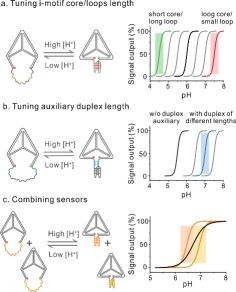Recently, Analytical Chemistry (JCR Q1,IF: 6.986) of the American Chemical Society published online the latest research result of our college entitled "programmable DNA framework sensors for in situ cell surface pH analysis" (Anal. Chem. 2021, 93, 12170-12174). Prof. Junqing Hu, Dr. Shiliang He and Prof. Shuangchen Ruan were co-corresponding authors. Dr. Jingxin Liu from College of Health Science and Environmental Engineering was the first author of this paper.
Many pathological processes (eg., cancer development) are associated with abnormal pH changes, either intracellular or extracellular. Gaining knowledge of pH alteration in cellular milieu will thus contribute to the understanding and interference of these processes. The development of programmable sensors relies on precise control over two parameters: response midpoint and sensitivity. In a typical sigmoidal response curve, the inflection point represents the response midpoint, and the difference between target concentrations yielding 10% and 90% output signals (i.e., dynamic range) defines sensitivity. However, chemical sensors often carry fixed response midpoint and dynamic range, which hinders their usefulness where concentration changes of the target over any specific concentration range need to be monitored with precision.
In response to the above considerations, this work developed strategies to rationally engineer cellular milieu-appliable pH sensor with programmable response behaviors (Figure 1). Specifically, this work adopted tetrahedral DNA framework (TDF)as a robuststructural skeletonfor the sensor in biological working scenes, and DNA i-motif structures of various sequence compositions as pH-responsive structure-switching module.
In general, the strategies reported in this work enables the generation of responsive nanoarchitectures withprogrammability, thus creating new opportunities for developing new functional bio-probes, which show great potential for a myriad of applications in biomedicine, cancer diagnostics and treatment.

Figure 1.Three strategies to engineer programmable pH sensors.